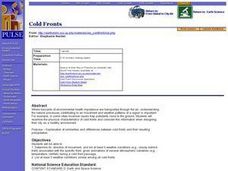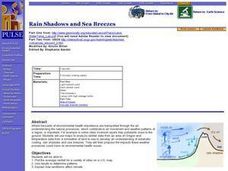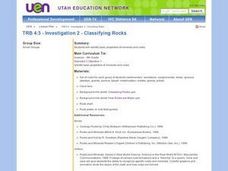Curated OER
Plates on the Move
Young scholars explore how Africa appears to be tearing apart from Asia and tha the other continents are moving and oceans are changing size.
Curated OER
Cold Fronts
Learners determine its' direction of movement, and list at least five weather conditions associated with the specific front, given animations of several atmospheric variables during a cold front passage. They list at least three weather...
Curated OER
Rain Shadows and Sea Breezes
Students plot the average rainfall for a variety of cities in the United States. Using the map, they work together to determine patterns on which toxicants are transported through the air. They determine the impacts of various weather...
Curated OER
Investigation 2 - Classifying Rocks
Fourth graders identify basic properties of minerals and rocks. They access websites and utilize worksheets imbedded in this instructional activity to further their understanding of rock classification.
Curated OER
Getting to Know Soil
Students make predictions and analyze soil. In this soil properties instructional activity, students make predictions about soil properties for various soil samples. Students examine the types of soils and record their observations....
Curated OER
How Volcanoes Grow
Young scholars study volcanoes including rock fragments, ash, aerosols and gases. In this volcano instructional activity students divide into groups and build models of the three major types of volcanoes.
Curated OER
Modeling Oil and Gas Reservoirs
Students investigate energy by researching how oil reservoirs work. In this fossil fuels lesson plan, students conduct an experiment using a half full bottle of water, corn oil and oxygen, recording their data as the elements are mixed...
Curated OER
Comets
Students explore the nature and composition of a comet. They research comet facts, legends, and myths. They identify different types of comets and describe what happens to a comet as it travels closer to the Sun.
Curated OER
Relative Dating - Telling Time Using Fossils
Students use fossil range charts to explain relative dating. They graph for ammonites, marine organisms that went extinct at the same time as dinosaurs.
Curated OER
Bite Sized Core Sampling
Students define the origin of rock samples and how surface core samples can tell us about the history and make-up of Mars. Candies are used as a Martian surface sample. Students study the samples and make a hypothesis about the cause of...
Curated OER
Processes of the Rock Cycle
Students explore, predict, and create each major rock form (sedimentary, metamorphic, and igneous) with colored modeling clay, discover cycle of rock formation, and examine important relationships of heat and pressure in rock development.
Curated OER
Who Was Here First? Relative Dating
Students read about and complete question activities for the topic of relative dating. In this relative dating lesson, students read information for the topic and then complete two activities to further their understanding of geologic...
Curated OER
The Ozone Between Us
Students investigate how ground level ozone occurs in many areas of the country. They study the ozone problems that are associated with population centers.
Curated OER
Structural Geology Laboratory
Students explore modeling of geologic structures in experiments. They study how compressive and tensile forces produce these structures. The compression makes the flatlying strata shorter and tension make the strata longer.
Curated OER
What is the Rock Cycle?
Students investigate the rock cycle. In this geology lesson, students read about the rock cycle on a website and discuss the steps of the rock cycle. Students visit a rock cycle website to complete a quiz. This is the first introductory...
Curated OER
Rocks and Minerals: Sedimentary Rocks
Students explore the concept of rock formation. In this sedimentary rocks lesson, students observe and record their findings about sedimentary rocks. Students then create limestone, coal, and sandstone models and write reports...
Curated OER
Energy and the Environment: What Can We Do?
Learners consider the impacts of global warming and brainstorm ways to help decrease their contribution to the problem. In this climate change lesson, students are exposed to facts concerning global warming and think of ways to...
Curated OER
Molecular Origami
Young scholars construct an origami models of different molecules. For this chemistry lesson, students explain what expansive soils are made up of. They discuss what happens when this expansive soil expands or shrinks.
Curated OER
My Time
Students create a timeline of their lives. In this timeline lesson, students discuss relative and absolute time. They use events in their lives to create categories on a timeline. They link this lesson to geologic timelines.
Curated OER
Dating Popcorn
Students simulate the dating process with popcorn. In this geology lesson, students discuss how geologist find the age of rocks by gauging the amount of decay of radioactive elements. They have 6 bags of popcorn and each group microwaves...
Curated OER
Exploring Rocks
Students recognize differences in the size, shape, texture, and color of different rocks. In this rocks lesson plan, students also learn and repeat back how a volcano erupts and make one out of a toilet paper tube.
Curated OER
Plate Tectonic - Volcanoes (1)
Students learn the different shapes of Volcanoes and discuss why volcanoes only have a few shapes.
Curated OER
The Environments of Big Sur -- Which Do We Protect?
Students investigate the geological, climatic, and biological features of Big Sur. They watch a video, conduct Internet research, and create a script and images in the form of an outline in a simulation of an environmental group.
Other popular searches
- Science Earth Layers
- Science Earth's Layers
- Earth Science Layers of Earth
- Earth Science Earth's Layers
- Earth Science Earth Layer
- Science Earths Layers

























